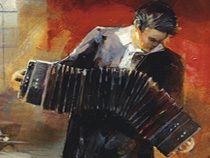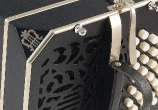


How does The Bandoneón work?
Because of its size and weight, the Bandoneon is usually played sitting down. It is said that Juan Maglio Pacho (circa 1912) one of the earliest composers of Tango and Bandoneón player, would play standing up, but rested the leg supporting his instrument on a log.
The main difference between the Bandoneón and accordion is one of sound. Accordion makers aim for a degree of homogeneity in the sound of individual registers and variety is provided by changing registers (varying the number and tuning of reeds selected by means of switches). Bandoneóns do not have register switches but the timbre of the instrument is constantly changing, depending on the air pressure, direction of the bellows and choice of keyboard for the melody and accompaniment. In addition, the playing position allows for much stronger accentuation than is possible on the accordion, and sound control techniques such as vibrato. The accentuation characteristic of tango is created by the way the reeds “overblow”, producing an edge to the note that cannot be reproduced on other free reed instruments.
The tango Bandoneón is a 71 button (142 voice) bisonoric instrument with two reeds per note tuned in octaves. The keyboards are a development of the 65 button layout known as “Rheinische Lage” that was in use in germany in the late nineteenth century; the extra six buttons were added to meet the requirements of tango musicians. The core of the layout is similar to the Anglo or German concertina. The tango Bandoneón has a chromatic range of just under five octaves from the C two octaves below middle C.
The range of the right hand (treble) is from A below middle C to the A three octaves higher, with the addition of top B opening (but no B flat.) The Left hand (bass) extends from A a sixth above middle C down to C two octaves below middle C (cello C string), with the addition of top B closing. The bottom third (C-E flat) doesn’t have all notes in both directions, but apart from that it is fully chromatic opening and closing.
"Felicia" by Adolfo Carabelli and played by Mariano Mores.
The Parts of A Bandoneón



